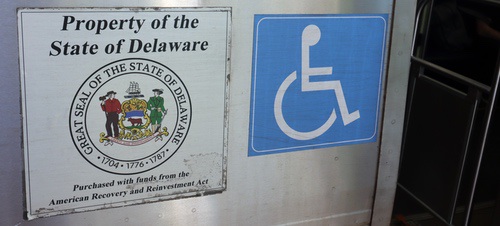Wilmington/Newark Line
on the SubwayNut
Most Weekday Trains Start/End
Weekend Trains:
To/From Chestnut Hill East
·Market East Station
·Suburban Station
·30th Street Station
·University City
·Darby
·Curtis Park
·Sharon Hill
·Folcroft
·Glenolden
·Norwood
·Moore-Prospect Park
·Ridley Park
·Crum Lynne
·Eddystone
·Chester Transportation Center
·Highland Avenue
·Marcus Hook
·Claymont
·Wilmington
·Churchmans Crossing
·Newark
The Wilmington/Newark Line operates along the southern portion of the Northeast Corridor from Philadelphia south to Delaware with service south of Marcus Hook subsidized by DART First State. Four Silverliner V Rail Cars were purchased by DART first state for SEPTA Regional rail. These all have signs on them by the train doors saying “Property of the State of Delaware, Purchased with funds from the American Recovery and Reinvestment Act.” These cars rotate throughout the SEPTA Regional Rail System.
The Wilmington/Newark Line is currently SEPTA's longest line. It operates on the portion of the Northeast Corridor south of Philadelphia for 37 miles down to Newark, Delaware. The core of line operates to and from Marcus Hook (the last stop in Pennsylvania) hourly or better on weekdays. Service to and from Wilmington is every two hours or better on both weekdays and weekends (trains on weekends operate every two hours along the entirety of the line). Service to and from Newark is during rush hours only.
As of January 2025, their are three AM trips arriving in Newark between 6:15am and 8:46am and departing between 6:43am (plus the 5:52am trip that has deadheaded) and 9:12am. There are five PM rush hour round-trips that arrive between 3:35pm and 7:45pm and return to Philadelphia between 3:54pm and 8:05pm. These trains don't consistently interline with any of the ex-Redding Lines during weekdays with many trains terminating and originating at Temple University. On Saturdays, Sundays and Major Holidays, all trains interline (except the first Marcus Hook-bound train of the train) with the Chestnut Hill East Line.
This line has had a complicated history as bi-state commuter rail lines often do (see the MBTA Providence Line). When SEPTA regional rail took over operations from Conrail on January 1, 1983, all service terminated at Marcus Hook because the State of Delaware didn't want to fund service into the First State. On January 16, 1989, service to Wilmington, Delaware was restored with Claymont Station reopening in 1991. Service to and from Newark began in 1997, with Churchmans Crossing opening as an infill station in 2000.
The stations along the Northeast Corridor in Pennsylvania are similar to the Trenton Line, blink and you miss while on a high-speed Amtrak train very short low-level platforms. The exception to this is Chester Transportation Center where an argument could be made to have limited Amtrak trains stop at this station, it was an Amtrak stop on the commuter oriented Chesapeake operated between Philadelphia and Washington, DC.
